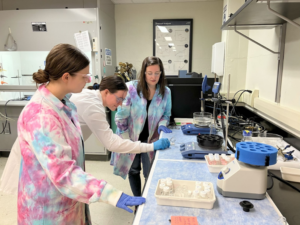Advanced Material Design and Characterization
Chemical engineers play a vital role in the design and development of new materials that enable modern technologies and drive innovation across industries. By applying principles of chemistry, physics, and engineering, they create materials with specific properties tailored to meet the demands of everything from sustainable packaging and biomedical devices to aerospace components and renewable energy systems. A key part of this work involves understanding structure-property relationships—how a material’s molecular or micro-scale structure influences the material’s behavior and performance. Here at Lafayette ChBE, research in this area focuses on the design and development of sustainable and biomimetic soft materials for applications in drug delivery, eco-friendly plastic products, smart materials, and more.
Computational Catalysis & Materials Design Lab
Our lab designs and discovers materials with tailored surface properties for energy and catalytic applications. We combine quantum mechanical simulations with data-driven modeling to uncover atomic-scale mechanisms that guide the rational design of functional surfaces. Current research focuses on two main areas: studying oxygen vacancies on titanium oxide surfaces to understand how defects influence adsorption and catalytic behavior, and using machine learning and large materials databases to predict phase stability and surface properties of metal carbides. Together, these efforts aim to advance the design of materials for energy conversion, catalysis, and sustainable surface technologies.
Polymers Lab of nature-inspired design
 Nature inspires and informs the design of new materials. By looking to nature, we design materials offering desirable properties such as response to environmental stimuli, improved safety, and sustainability via two main thrusts: 1) bio-inspired (or “smart”) polymers that respond constructively to their environment and 2) bio-based polymers that are sourced from renewable feedstocks. Our approach involves designing the polymer at the molecular level by incorporating structural building blocks inspired by or derived from nature. By modifying the chemical makeup of these materials, we can tune their responses and thereby engineer materials for diverse applications, such as in drug delivery, sustainable plastic packaging, and membranes.
Nature inspires and informs the design of new materials. By looking to nature, we design materials offering desirable properties such as response to environmental stimuli, improved safety, and sustainability via two main thrusts: 1) bio-inspired (or “smart”) polymers that respond constructively to their environment and 2) bio-based polymers that are sourced from renewable feedstocks. Our approach involves designing the polymer at the molecular level by incorporating structural building blocks inspired by or derived from nature. By modifying the chemical makeup of these materials, we can tune their responses and thereby engineer materials for diverse applications, such as in drug delivery, sustainable plastic packaging, and membranes.
Find out more: Polymers Lab
Polymer Thermophysical Properties Lab
One of the foundational principles in materials science and engineering is the connection between the material’s structure, both chemical (bonding) and physical (assembly), and its properties, like strength, flexibility, conductivity, corrosion, etc. Research in our lab is focused on the physical assembly of polymers, or plastics. This includes crystallization and phase separation in multicomponent systems. Temperature is one of the most important variables to influence the development of the polymer’s physical structure, though not the only one. By understanding how the polymer behaves with changes in processing temperature, it is possible to tailor the material’s properties for applications such as biodegradability, drug delivery, elasticity, electrical conductivity, light propagation, and many others. Using an array of experimental and analytical techniques, we develop a stronger understanding of the relationship between the polymer’s physical structure and engineering properties to help design new or better applications of plastics. Undergraduates of all class years are critical contributors and drivers of the research efforts in our lab.
